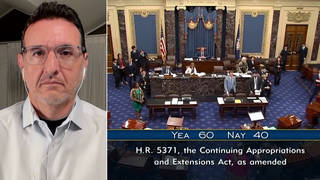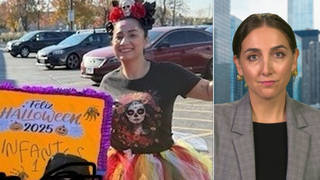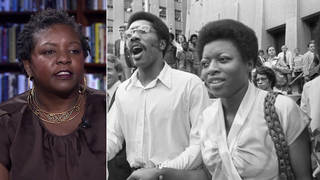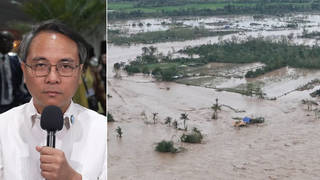
Topics
Guests
- Andrea Pitzerjournalist and author. Her book is titled One Long Night: A Global History of Concentration Camps.
A humanitarian crisis is unfolding in Burma, where more than 400,000 members of the Rohingya Muslim minority have fled the country after hundreds of their villages were burned to the ground. The U.N. high commissioner for human rights has accused the Burmese government of waging a textbook example of ethnic cleansing. In the United States, there are increasing displays of anti-immigrant sentiment and anti-Semitism. In Palestine, the United Nations has warned the Gaza Strip has become uninhabitable. For more on concentration camps and anti-Semitism, we speak with journalist and author Andrea Pitzer. Her book has just been published, titled “One Long Night: A Global History of Concentration Camps.”
Transcript
AMY GOODMAN: This is Democracy Now! democracynow.org. I’m Amy Goodman, with Nermeen Shaikh.
NERMEEN SHAIKH: We end today’s show with a new book that examines the history of mass civil detention without trial. It comes as a humanitarian crisis is unfolding in Burma, where more than 400,000 members of the Rohingya Muslim minority have fled the country after hundreds of their villages were burned to the ground, and the U.N. high commissioner for human rights has accused the Burmese government of waging a textbook example of ethnic cleansing.
AMY GOODMAN: Meanwhile, in the United States, there are increasing displays of anti-immigrant sentiment and anti-Semitism. At last month’s Unite the Right rally in Charlottesville, Virginia, neo-Nazis and Ku Klux Klansmen displayed swastikas, marched with torches. Members of the local synagogue, Congregation Beth Israel, said men dressed in fatigues and carrying semi-automatic rifles stood across the street, prompting people to leave their Saturday service from the back of the synagogue in groups as a safety precaution. A recent column in Newsweek detailed additional security plans by a Jewish congregation in Texas to celebrate this week’s High Holy Days at an undisclosed location.
For more, we’re joined by Andrea Pitzer, journalist and author. Her book has just been published; it’s titled One Long Night: A Global History of Concentration Camps.
Andrea Pitzer, welcome back to Democracy Now! Why don’t you start by responding to what has taken place in the last month? And then talk about why you’ve chosen to do this global history of concentration camps.
ANDREA PITZER: Well, unfortunately, right now I think that we are in a period where sort of intolerance and labeling the other and looking at people as a danger to society, looking at whole groups of people as a danger to society, has become acceptable again. And this obviously isn’t just in the States. This is something that’s happening worldwide. We’re seeing it in European elections. We’re seeing it here in the U.S. with some of these Nazi demonstrations. We’re seeing it in Burma, as you mentioned. And I think there’s a little bit of pendulum swings that happen. And certainly, you know, economics can be part of the issue, as well. But I think that you do end up in a dangerous loop that we’ve seen before between sort of a public sentiment rising and then people coming to power that reflect that sentiment and then reflect that idea back to the larger population, where it sometimes gets amplified.
So, I do think this is a really critical moment for us to be paying attention to some of these issues. And I’d like to say that’s why I wrote the book, but, of course, I started the book years ago, before we hit this wave. And at the time, I realized that this was a phenomenon that went further back than the Nazi camps, and it went all the way back to the 1890s. And I don’t think people are really aware of this long, pre-Nazi-death-camp history of concentration camps, because looking back from the vantage point of today, the idea of a developed nation bending all its modern might into the annihilation of a people is so huge still, in this singular moment in history, that it kind of obscures everything that came before and came after. But there’s really a very long story that I think needs to be paid attention to, because these things don’t rise out of nowhere. And so, learning the warning signs, learning to pay attention, seeing how everything did unfold—
AMY GOODMAN: Well, so, tell us. Tell us that history. Go back to the turn of the 20th century, right before, to the first concentration camps.
ANDREA PITZER: So, the first concentration camps were set up by the Spanish Empire in Cuba in the late 1890s. And they were fighting a rebellion. So you had these guerrillas, and they weren’t able to defeat it, and there were chronic battles over decades. And finally, the governor-general there suggested that the only way that they would be able to defeat the rebels, who wanted independence, would be to sweep all the peasants out of the countryside and put them behind barbed wire. And then you could basically shoot anyone who was left. Anyone who didn’t heed the call to report and head into these camps could be identified as an insurgent and shot on sight. And so, it was really a frustration with the guerrilla fighters that they couldn’t pin down and they couldn’t win over, but—they couldn’t defeat. But the thing is, this man, who thought of it, did not actually impose those camps, because he wrote to Spain to say that “As a representative of a civilization, I can’t do this, because this is going to bring misery and hunger, and it’s going to be terrible.” So Spain recalled him and sent in someone named “the Butcher,” who was happy to do that. And so, that’s where the first camps came from.
And you actually see that situation, with an insurgency or guerrilla war or civil war, happening again and again. And once it had been sort of thought of to put these civilians in camp, which was a shocking idea at the time—I mean, worldwide, response was that this was going to be tragic and many people would die. And they were right. More than 100,000 people died in those first camps. And that’s a big part of why the U.S. actually went to war with Spain in 1898. Of course, there was the sinking of the Maine that everyone remembers, but the American public had been hearing about these camps and seeing photos of them for a very long time by the time the Maine sunk. And so, it really was the huge cause to go to war. And McKinley, at the time, the president, McKinley, announced in his call to war to Congress—he said, “This is not war by any civilized means. This is extermination, and it leads to nothing but the wilderness and the grave.” Unfortunately, after we defeated Spain handily, in just a matter of weeks, really, we inherited the Philippines. And just a short number of years later, the U.S. imposed its own concentration camps in the Philippines.
So, once this idea had taken root in the world, it was really impossible to get rid of. And you saw it used in colonial outposts. And then, in World War I, it became this global phenomenon. So, really, in the space of just a few years of World War I, it went from being an institution that had been brought in just a few places to a bureaucracy of civilian detention that sort of went around the world. And from that, once you have that in place, you see all these local versions of camps grow out. So, out of the Russian camps from World War I, we see some of the roots of the Gulag. Out of the German camps from World War I, we see some of that institution and the approaches to it borrowed for what become the Nazi camps later. So, everyone, from there, uses their local culture, if you will, some of which had prior forced labor camps in history—they had other things—but they combine it with this idea of mass civilian detention without trial.
NERMEEN SHAIKH: Well, one of the places that you mention in the book, and which of course is in the news now, is Burma and the Rohingya camps there. So can you talk about what you found when you were there in 2015?
ANDREA PITZER: Yes. So, I went there in June 2015. And it was very interesting, because when I went, it was just two weeks after Donald Trump had declared his candidacy, and no one was taking him seriously at that point. But the rhetoric he was using already, about Muslims, about Latinos, was exactly the rhetoric that I heard when I landed in Sittwe, which is on the western coast of Myanmar and is the capital of Rakhine state, where these Rohingya camps are located. And it was kind of unsettling to me at that time to be—to notice so clearly that this kind of rhetoric is really a universal rhetoric. And the brakes on it seem to be how strong are the institutions in a given place. And, of course, in Myanmar, the institutions are not strong. It’s a fledgling democracy. It’s really made the move only in recent years from a military dictatorship to a democracy, and the military still has a tremendous amount of control.
So, when I went there, I went to see the camps. I went to Yangon, and then I went to Sittwe. I went into the camps and talked to the Rohingya there. I talked to people in town in Sittwe who were in support of the camps, of their neighbors being held in these camps. And what I found on the side of the detainees was that the rioting that had happened in 2012, that had led to the camps, had destabilized the region. And they were unhappy at being put in these camps, but because it was so dangerous for a period of time, there may have been some early protective role for them, you know, in the camps. So, even though they didn’t like the camps, they understood that, early on, it might have been something that saved some of them. But the idea that the camps were temporary, which was said for a long time—five years later, now, is where we are today—is obviously just not true. And they had become very frustrated that there were no—
AMY GOODMAN: We have five seconds.
ANDREA PITZER: There were no moves being made to try to get them out.
AMY GOODMAN: Well, Andrea Pitzer, we want to do Part 2, and we’ll post it online at democracynow.org. Her new book, just out, One Long Night: A Global History of Concentration Camps.
And that does it for our show. Juan González will be speaking in Newark, New Jersey, tonight at the Abyssinian Baptist Church at 7:00, then next Friday, not tomorrow, in Kansas City, Missouri. I’ll be going all through Canada on the last week of September. Check our website. Our website is democracynow.org.










Media Options